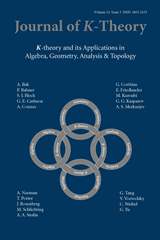Article contents
K-theoretic exceptional collections at roots of unity
Published online by Cambridge University Press: 11 May 2010
Abstract
Using cyclotomic specializations of equivariant K-theory with respect to a torus action we derive congruences for discrete invariants of exceptional objects in derived categories of coherent sheaves on a class of varieties that includes Grassmannians and smooth quadrics. For example, we prove that if  , where the ni's are powers of a fixed prime number p, then the rank of an exceptional object on X is congruent to ±1 modulo p.
, where the ni's are powers of a fixed prime number p, then the rank of an exceptional object on X is congruent to ±1 modulo p.
- Type
- Research Article
- Information
- Copyright
- Copyright © ISOPP 2010
References
- 4
- Cited by




